Battle of Jefferson City, Missouri, August, 1912
Nov 4, 2018 18:48:20 GMT
mikedski, boxholder, and 2 more like this
Post by scottwashburn on Nov 4, 2018 18:48:20 GMT
Battle of Jefferson City, Missouri, August, 1912
Background
Following their devastating defeat at the Battle of St. Louis in June, the Martians of Clan Mavnaltak fell back toward their fortified holdfast near Kansas City.* General Leonard Wood, Chief of Staff of the US Army, dearly wanted to follow up on his victory and pursue the defeated enemy before they could recover. Unfortunately, by all indications Martian forces further south were preparing a major attack on the city of Memphis. The security of the Mississippi Defense Line was of primary importance and he did not have the reserve forces to mount a major drive toward Kansas City. However he did authorize General John Pershing, Commander of the 6th Army at St. Louis to mount whatever pursuit he felt could be safely undertaken with the forces at his disposal.
Pershing’s XV Corps, had been too badly battered in the defense of St. Louis to undertake such an operation, but the two other corps in 6th Army had not been engaged at all. Realizing that their sectors were in no immediate danger, Pershing created a new formation using units drawn from those corps, along with some support units from XV Corps. These units, supported by navy gunboats and monitors, moved cautiously westward, following the Missouri River during July.
Clan Mavnaltak was in a precarious position. They observed the prey-creature force approaching their holdfast with considerable alarm, but their losses at St. Louis had been so heavy they could not risk another major battle. In early August, their scouts noted that the prey-creatures had a substantial supply depot in the ruins of Jefferson City, along the Missouri River. It was decided that a fast strike against this depot might slow or even halt the enemy advance. A decoy force was sent to draw enemy forces away from the depot, while the raiding force moved into position.
American aircraft detected this force mere hours before it attacked. There was no time to send significant reinforcements to Jefferson City, but the defenders were on full alert when the Martian arrived, just before noon on August 6th.
The Battlefield
The land around Jefferson City is mostly flat with scattered patches of woods. The city and surrounding farms had been destroyed by the Martians when they swept through the area in 1910. There are substantial ruins where the city once stood. The Missouri river, flowing west to east was to the north of the city.
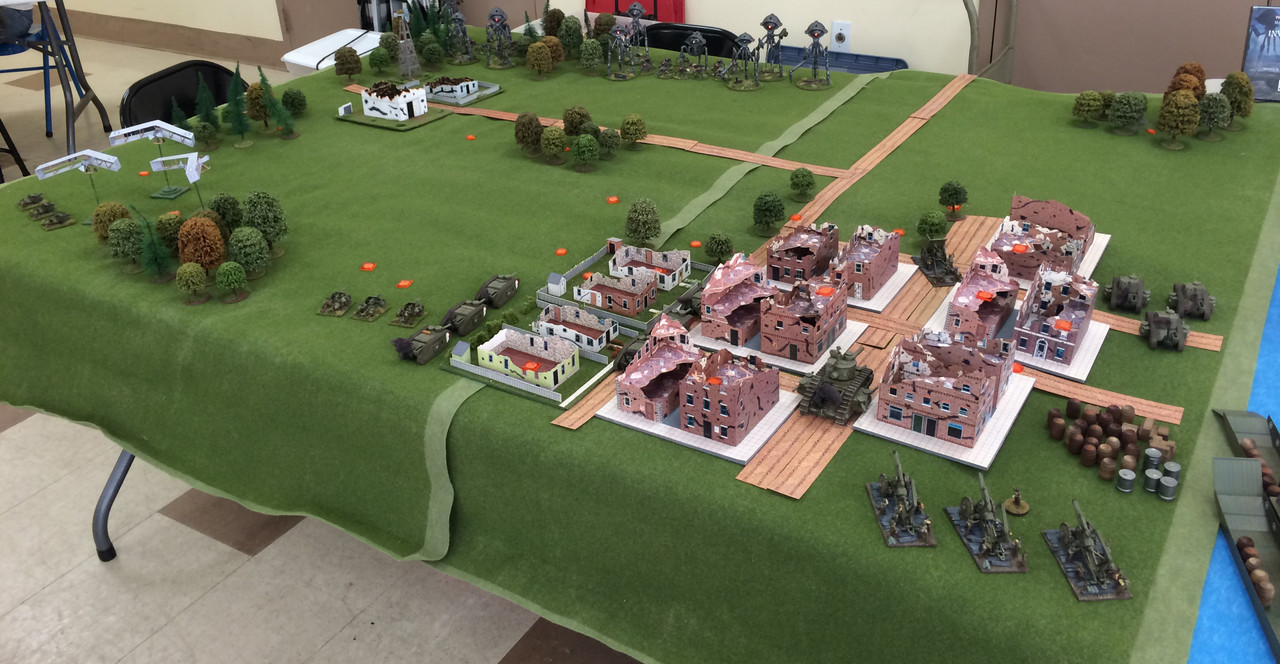
The Supply Depot
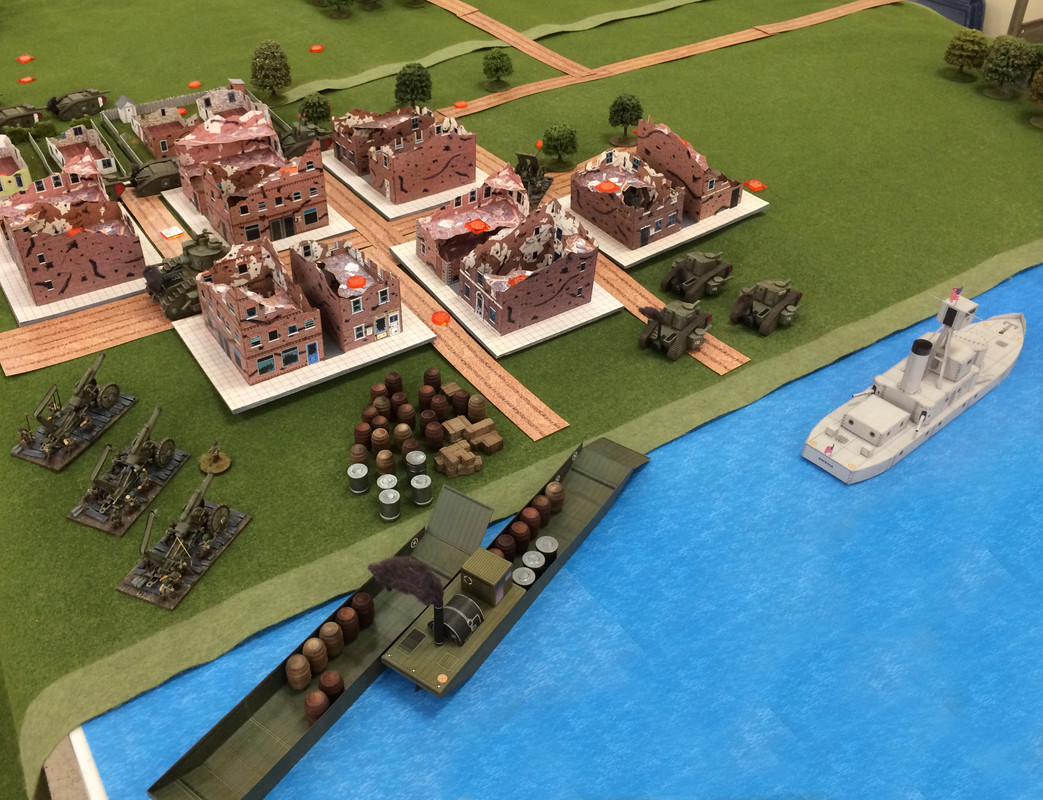
The Opposing Forces
The defense of the supply depot at Jefferson City had been assigned to the 1st battalion of the 109th Infantry Regiment. They were part of the 28th Division, the ‘Keystone Division’. Originally a Pennsylvania National Guard unit, the 28th had suffered heavy losses at the Battle of Santa Fe in 1910. While it had been rebuilt since then, the influx of new recruits had diluted the Pennsylvania flavor of the division, although they still proudly wore the red Keystone insignia on their uniforms. The battalion was structured along the lines of the newly adopted 1911 regulations, so it had three rifle companies, each of three rifle platoons and a machine gun platoon. The 4th company, the weapons company, had two machine gun platoons and two mortar platoons. All of the rifle platoons had one of new anti-tripod rocket launchers recently invented by Dr. Robert Goddard and called by the troops ‘stovepipes’.
The battalion was supported by two batteries of field artillery and an anti-tripod gun. By good fortune, a company of tanks, one of the massive Mk IV heavy tanks, and a battery of heavy artillery had been unloaded from barges just the day before and were available to join in the defense. A single flight of Burgess-Dunne D8 aircraft were observing the Martian approach and would be there for the coming battle. Finally, the Olmstead-class river gunboat, the USS Osceola, was on the river ready to lend its gunfire, if necessary.
The Martian attack force was a modest one consisting of five assault tripods, two mounting black dust projectors, three scout tripods, and two slaver tripods controlling twenty four drones.
Deployment
The Bulk of the human forces were deployed in and around the ruins of Jefferson City. B, C & D company held the town, long with the tanks. The heavy artillery battery was near the supply depot.
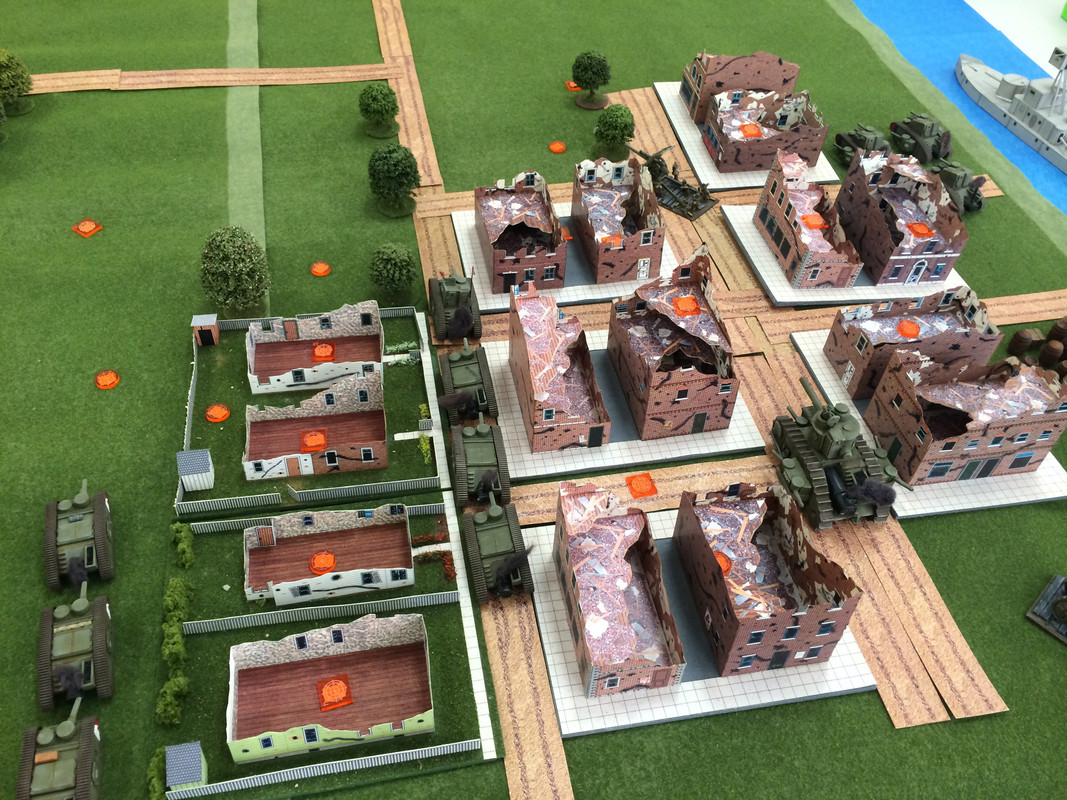
The two field batteries were deployed in open ground to the south of the city, supported by A Company of the 109th. The aircraft were circling in that same vicinity.
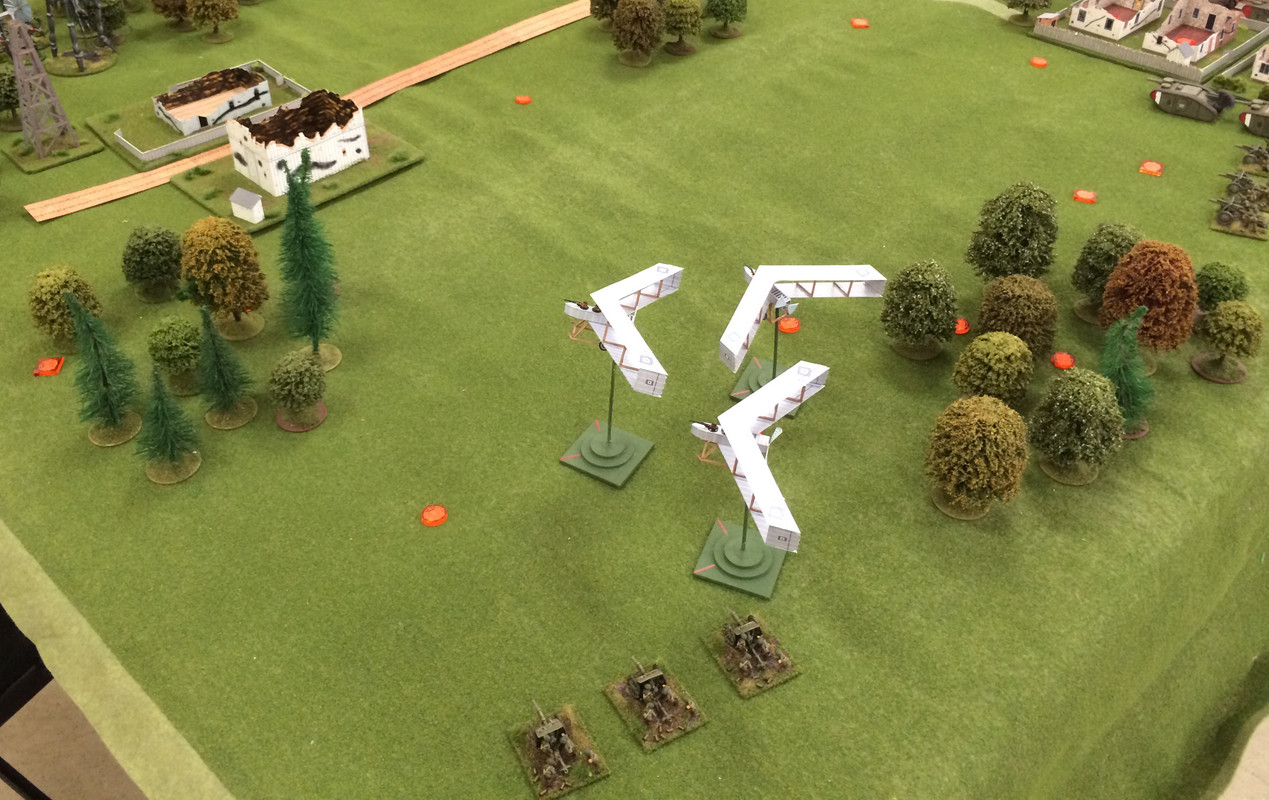
All of the infantry was deployed as hidden ‘blips’ and would only be revealed if they fired, or if a Martian unit came within 6” of them. A number of decoy blips were also deployed.
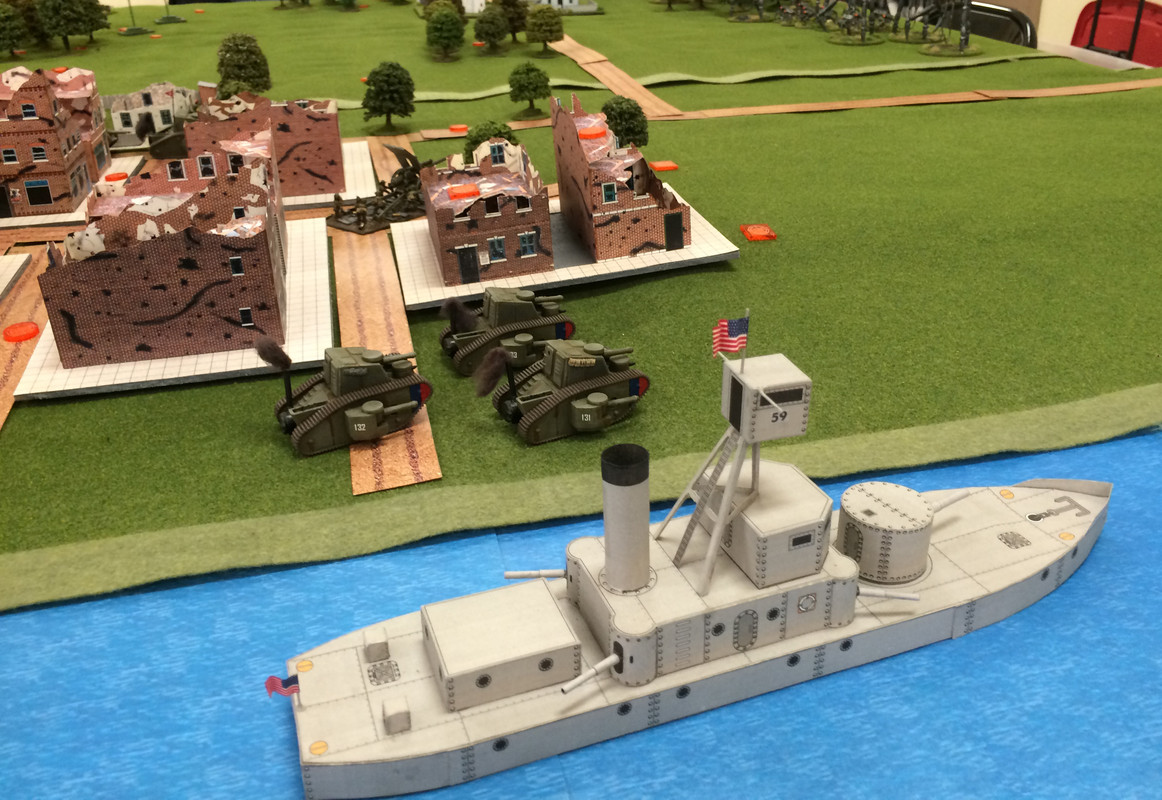
The Martians arrived along the southwest table edge, the drones clustering close to the slavers, which controlled them.
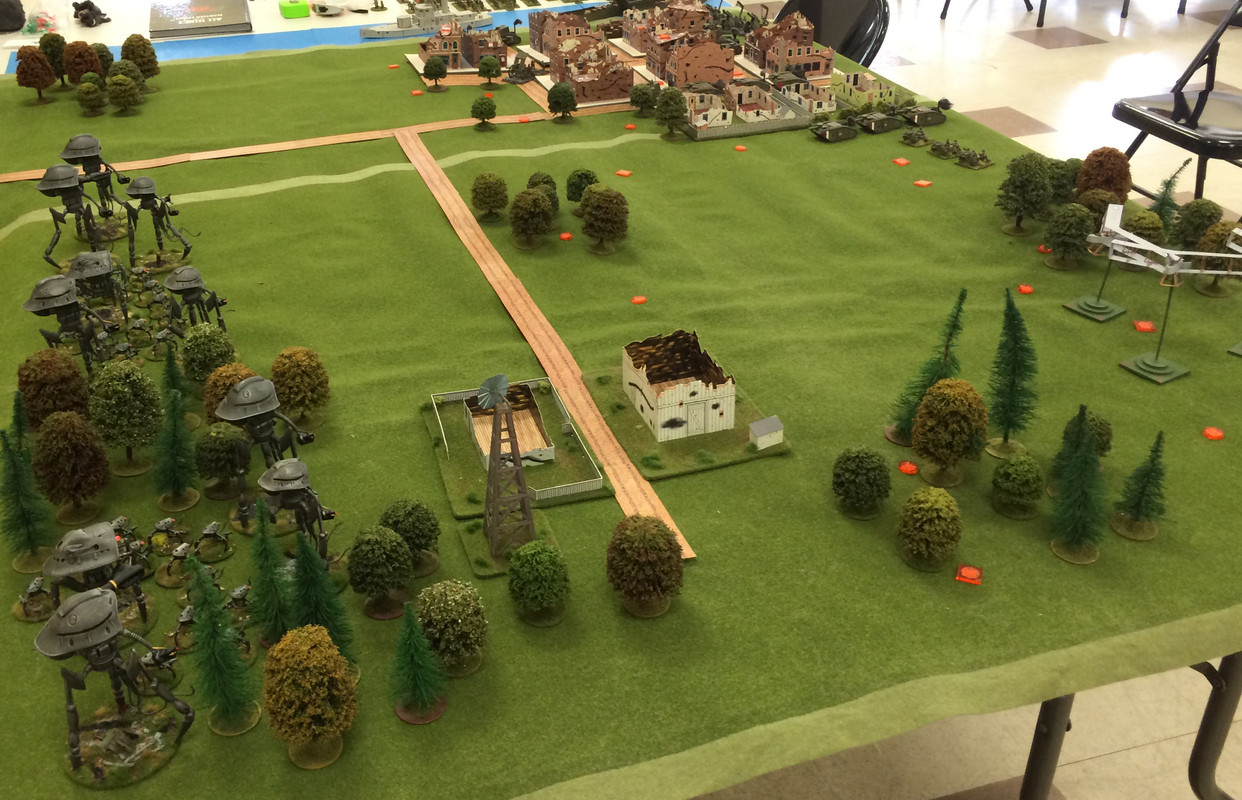
Both sides were given ten command tokens. The Martians could use them to give a double move to a unit. The Humans could use them for double-moves, to rally routed units, and bring back destroyed units as reinforcements.
The victory conditions were simple: The Martians would win if they destroyed the supply depot. The Humans would win if they prevented this. Each army had a break point of 50%. Once half of their starting units were destroyed, they would be forced to retreat.
The Battle
The Martians were given the initiative and made the first move. One of the Martian subordinates advised a rapid move to the north, up to the river and then a sweep east to the supply depot. This would leave the prey-creature forces to the south of the town unengaged and perhaps avoid a costly fight through the streets of the ruined city. The force commander, Icwelaner, was very wary of the prey-creature warship on the river. Such things had proven extremely dangerous in the past. It overruled its subordinate and decided upon an advance due east. Once the enemy forces to the front had been destroyed, the attack force would turn north and attack the supply depot.
Turn 1 saw the Martians advance straight ahead, expended several command token to speed movement. The only thing within range of their weapons were a few blip tokens, which when fired upon proved to be decoys.
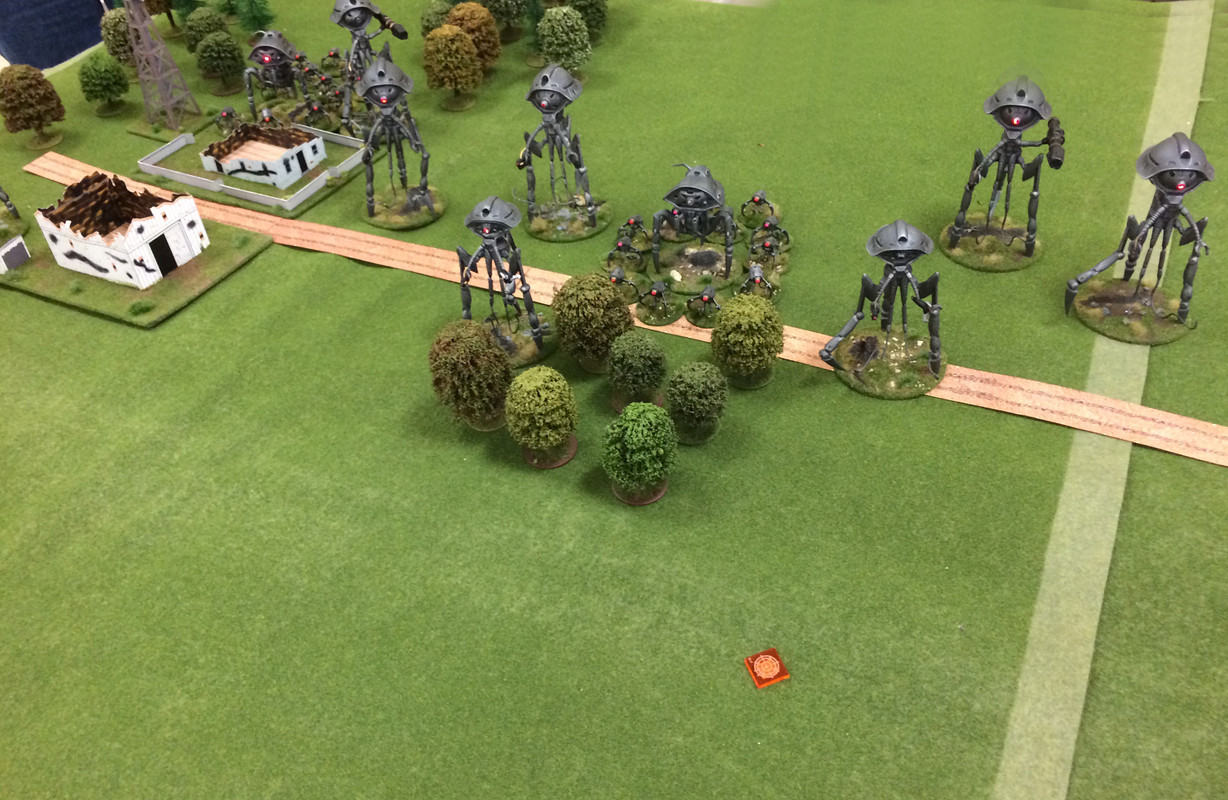
During their second move (All Quiet on the Martian Front uses a move-shoot-move turn system). A scout tripod on the extreme Martian right discovered a prey-creature infantry platoon in a patch of woods.
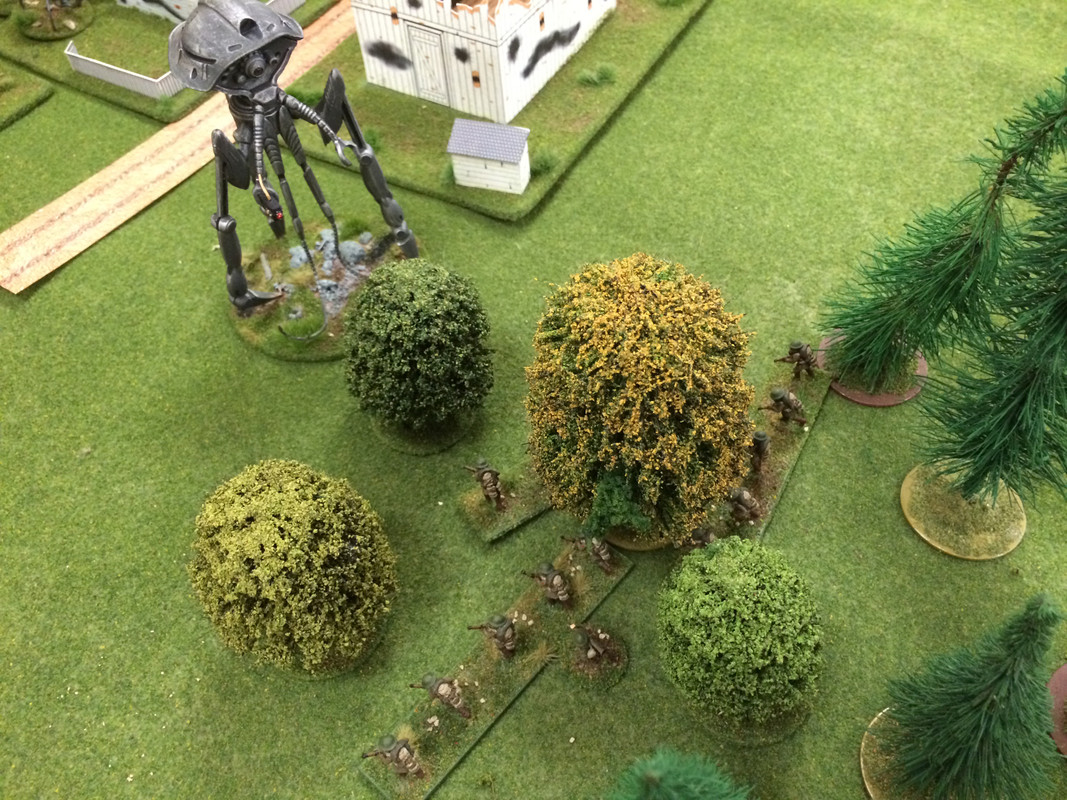
The human turn saw them moving their forces into positions where they could fire better. The tank platoons moved out of the streets and deployed in the open areas on the edge of town. The Mk IV tank used a command token to double move, but could not quite get a shot.
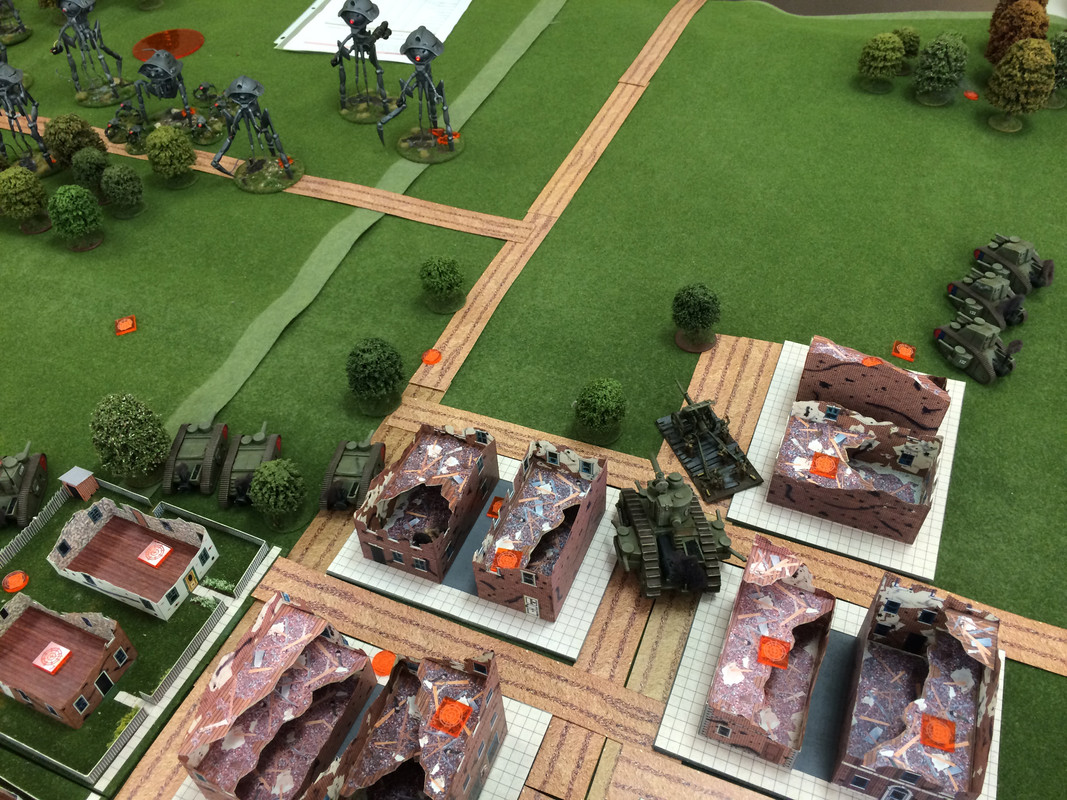
On the left, the discovered platoon charged boldly into contact with the scout tripod, hurling their explosive bombs and trying out their new-fangled stovepipe rocket launcher. The circling aircraft also headed for the scout, machine guns blazing. The assault was not terribly effective, the inexperienced rocket gunner sending his missile off into the trees. But an armor hit was scored and this was no little thing. An undamaged Martian machines was nearly invulnerable to small arms fire, but each armor hit left them more and more vulnerable. It would be easier to hit the scout the next time.
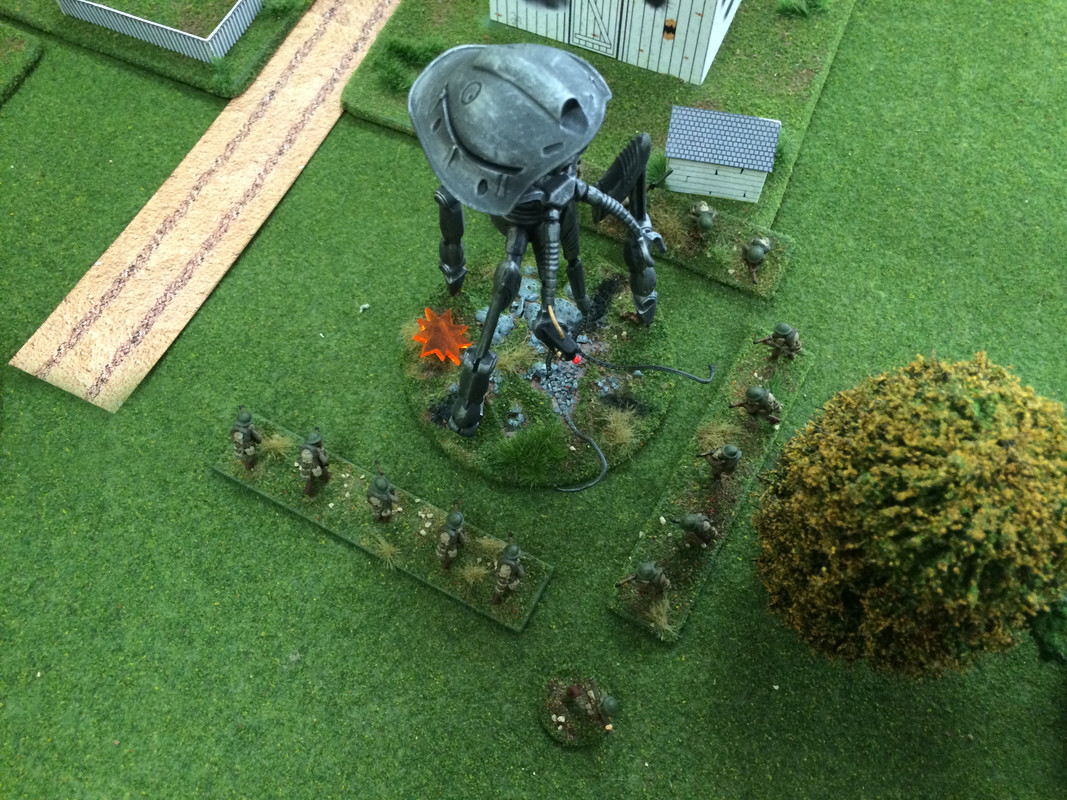
Over toward the town, the human defenders opened fire with everything that could be brought to bear. The heavy artillery battery dropped a barrage on the nearest slaver and although no damage was done on the tripod, two of the drones were blown to bits by the heavy shells. The tanks and field batteries, the anti-tripod gun and the 6” gun on the Osceola all blazed away and scored a number of armor hits on several of the tripods. No serious damage, but the Martian machines were becoming more vulnerable. On the humans’ second move, the infantry platoon on the left retreated back into the woods, and the aircraft turned away, not wanting to bring their fragile craft too close to the massed enemy tripods. In the town the Mk IV tank lurched into position where it could fire on the following turn.
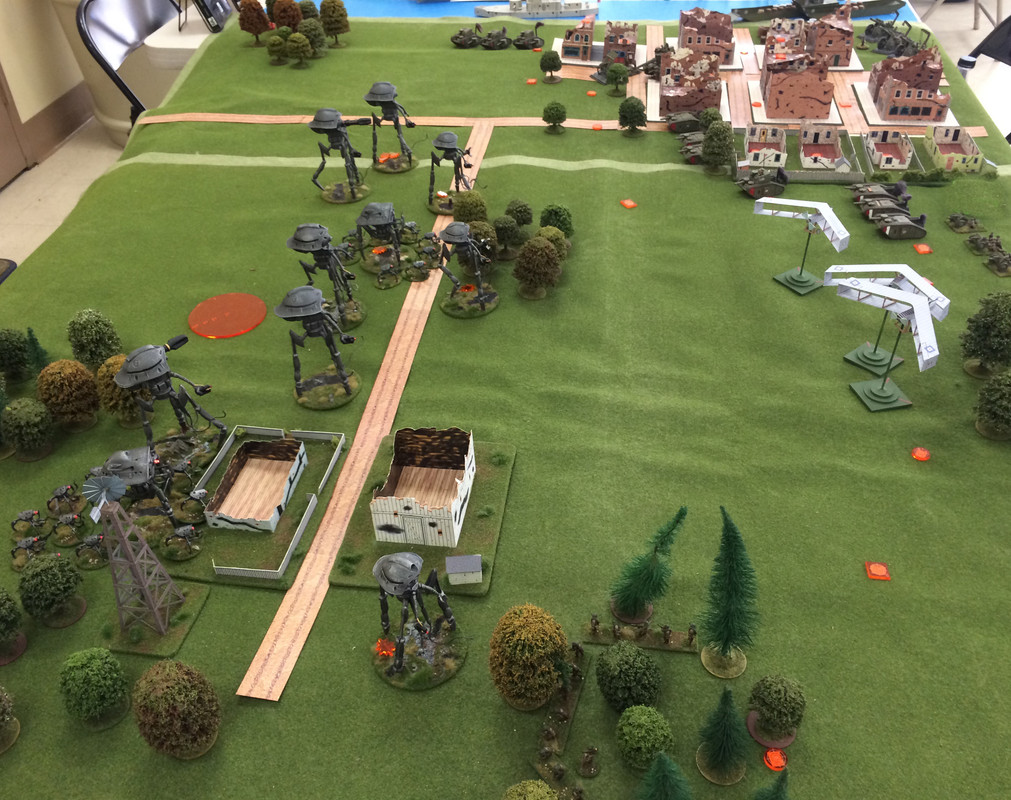
On turn two each side rolled a die to win the initiative for the turn and the humans won! This feature of the game system will, from time to time allow one side to get a double move and that is what happened here. The humans moved second on Turn 1, and now first on Turn 2. They could pound the Martians again!
The humans repositioned a few of their tanks and the infantry squad on the far left again charged out of the woods against the scout tripod. The flight of aircraft regretted turning away from the enemy in the second move of the previous turn as they were now too far away to attack this turn.
Fire rained down on the enemy again. The heavy artillery battery blasted away at the slaver and it’s drones and this time scored a hit on the slaver, not only knocking off an armor point but also damaging it’s directional controls. When it tried to move again, it might move in some direction the Martians did not want. Two more of the drones were destroyed as well. Fire from the other field batteries and the Mk II tanks near the town piled on more armor hits and also damaged the weapons control system of one of the assault tripods.
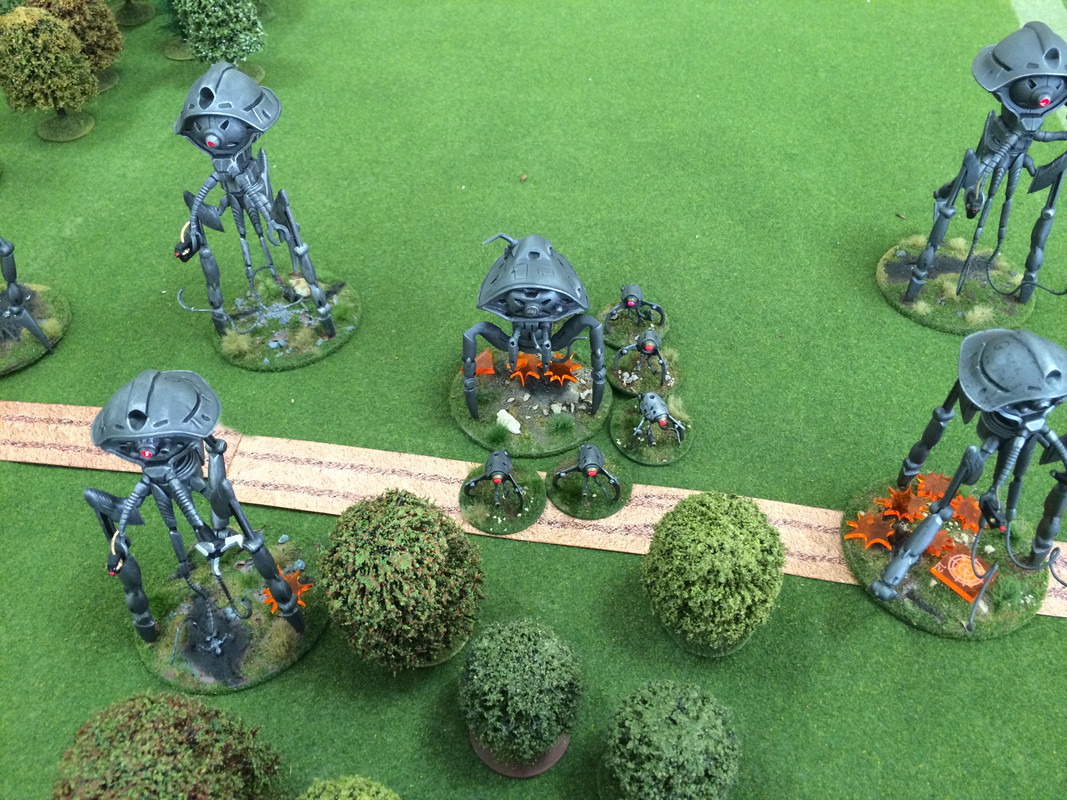
Then the three Mk III steam tanks on the far right trained their nine 4” guns on the nearest tripod and scored seven hits. That tripod had already suffered several armor hits so when the rolls were made to penetrate the armor five made it through! This meant a roll on the damage table with a +4 to the roll. Not surprisingly, the tripod exploded. Not only was it destroyed, but another nearby tripod suffered an armor hit. A cheer went up from the human lines.

Over on the far left, the plucky infantry platoon again assaulted the scout tripod, but scored no hits this time.
Finally, it was the Martian turn. The long-legged tripods continued their advance—except for the damaged slaver who went the wrong way. One of the scouts got close enough to reveal another platoon of A Company on the left. They also got close enough to sweep a heat ray across the circling aircraft. Two of the planes burst into flames and fell from the sky, the third fled and did not return.
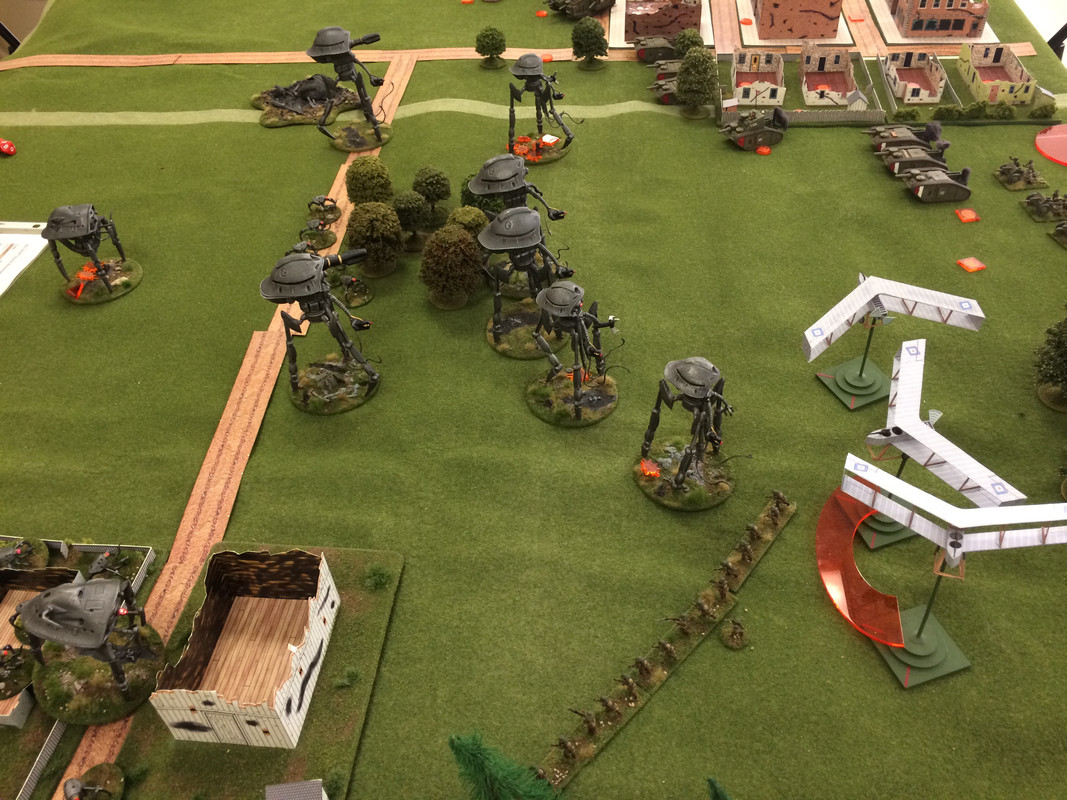
Another sweeping heat ray wiped out the newly revealed prey-creature platoon before it could fire a shot. Several longer range shots destroyed a steam tank and the tank platoon command tank. On the left, the lone scout finally managed to fire at the pesky infantry platoon in the woods—and missed!
With their second move the Martians continued to advance. Another infantry platoon was revealed in front of the field battery, and a machine gun squad in the woods. The scout on the far left decided it would leave the prey-creatures in the woods to the approaching slaver and drones and moved a double move toward the center.
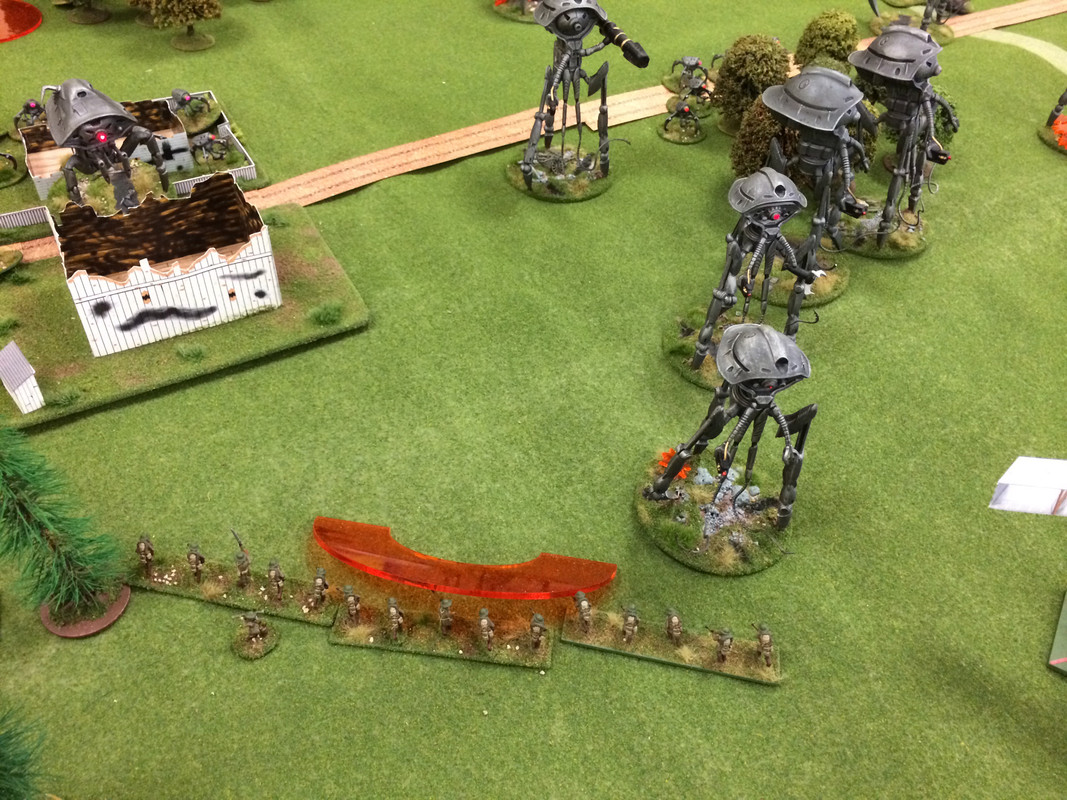
The Humans won the initiative roll for turn 3 and moved first. They brought several platoons out of hiding in the town and moved them into position to fire. Cutting loose with everything they had, they pounded the approaching Martians.
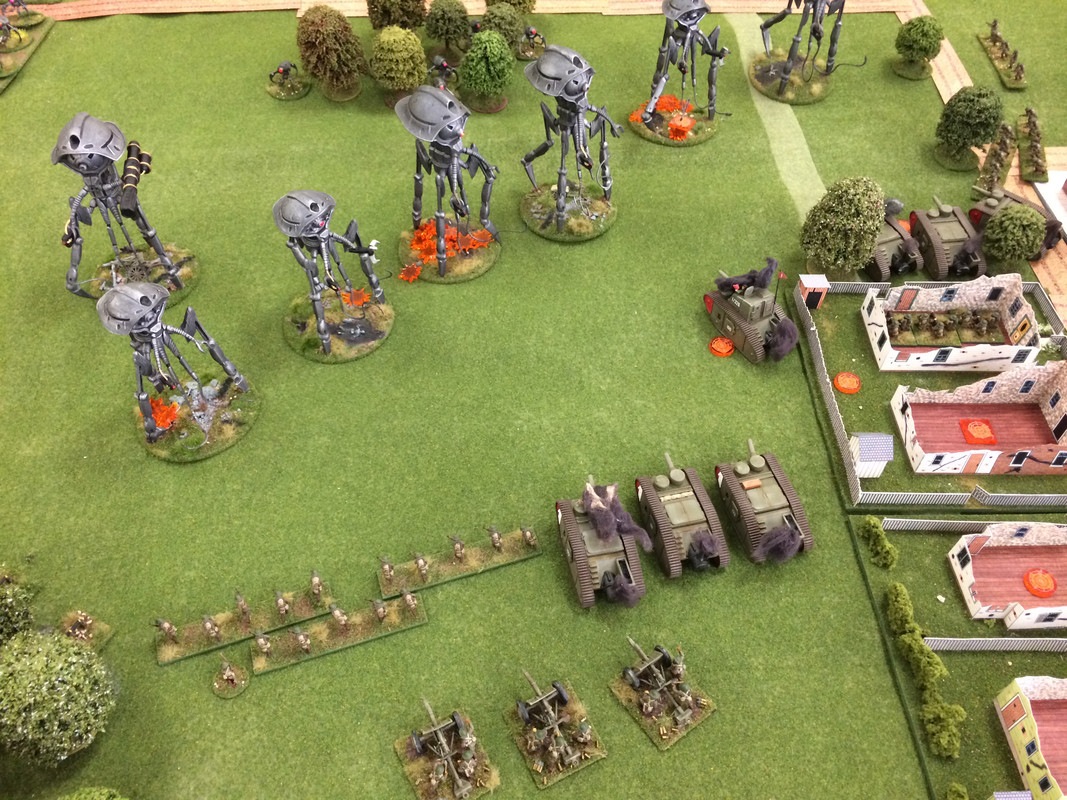
Hit after hit was scored and then in quick succession a scout tripod exploded, and another assault tripod crashed to the ground, completely wrecked.
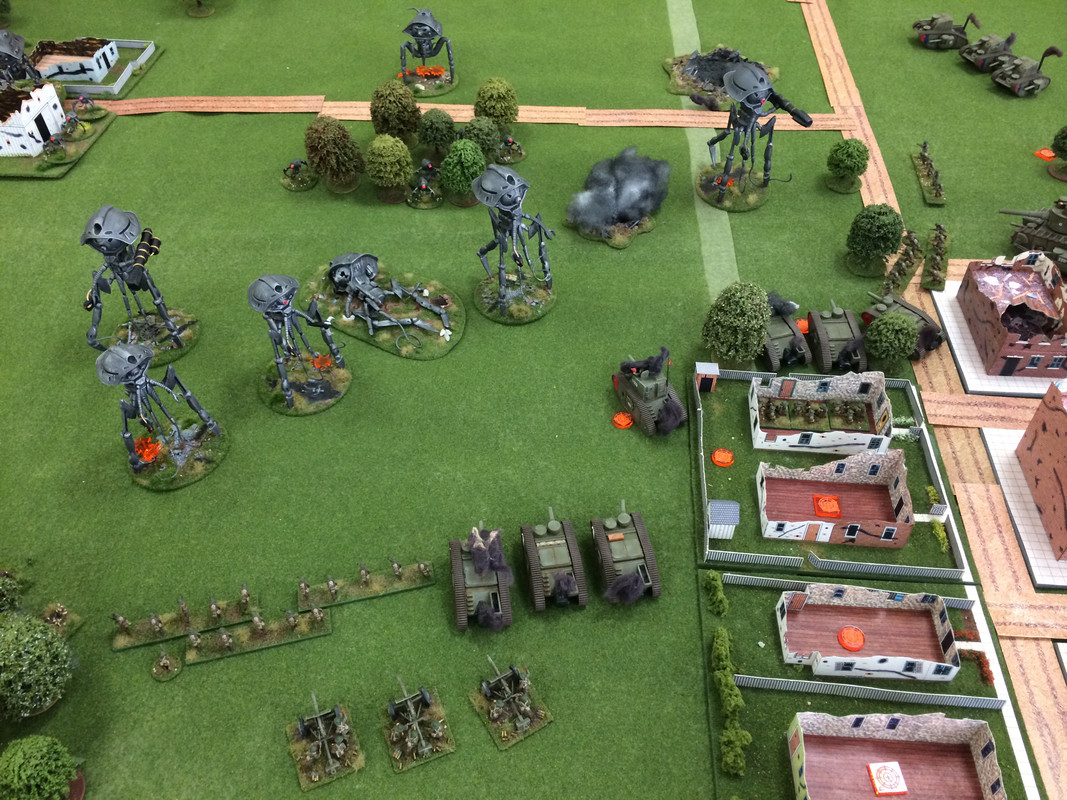
On the left the lone American platoon fired at the drones with no effect, but was heartened that another hidden platoon was moving up in support.

Well, things were looking very hopeful for the Americans. They had hurt the enemy badly. The Martian commander was starting to think that this operation had not been a good idea.
But it would obey its orders and continue the assault. On the left, the drones surged out of the ruined farm and quickly cut down every one of the irksome platoon in the woods. Of course this also revealed the second platoon ready to take its place.
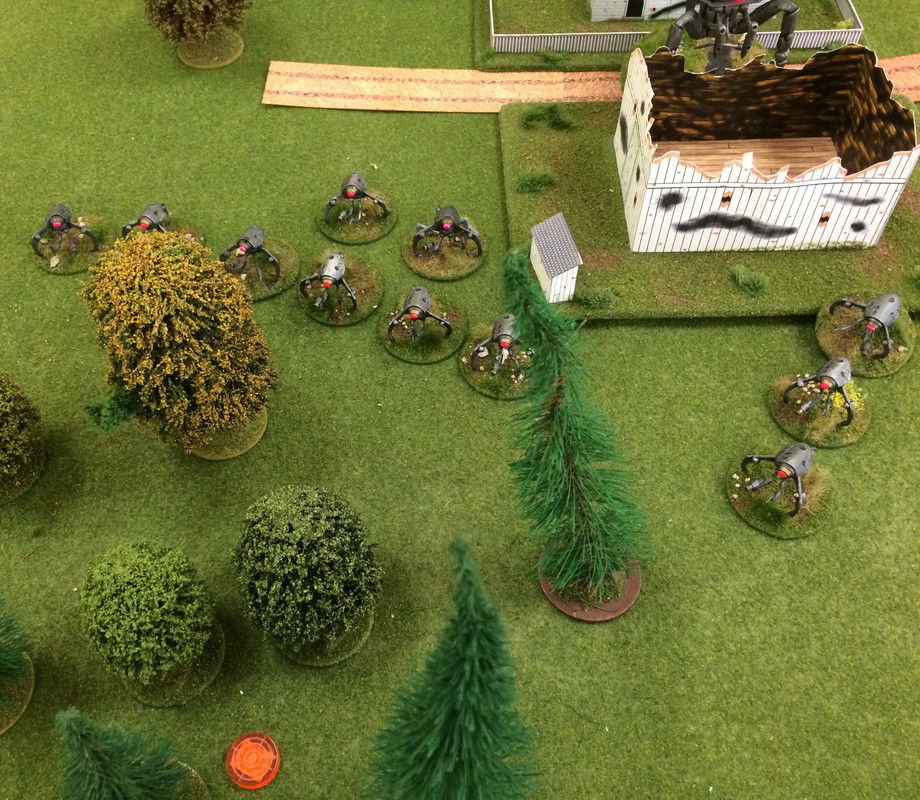
Closer to the town, things also turned for the better. The black dust projector on one of the assault tripods destroyed two of the machine guns in the woods, and a sweeping heat ray annihilated the field battery with one shot.
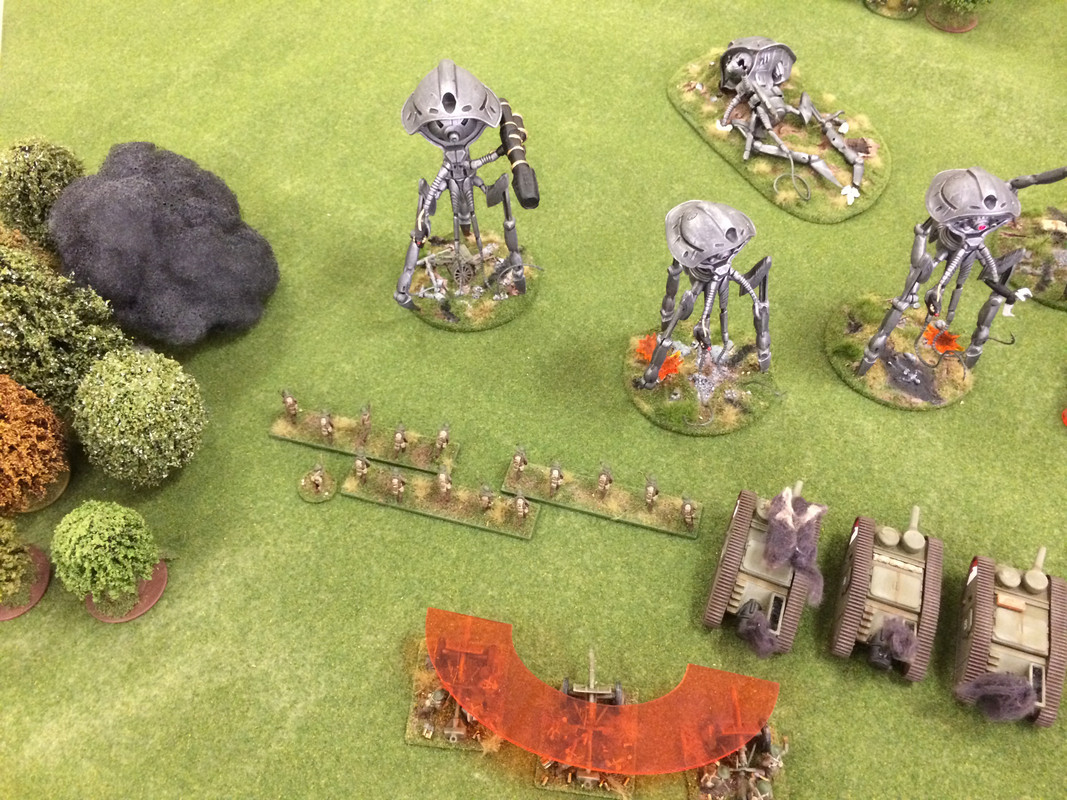
On the edge of town, more black dust killed or routed another platoon and a focused heat ray blew through the heavy armor of the Mk IV tank like it was butter and the huge vehicle exploded in a ball of flame and steam.
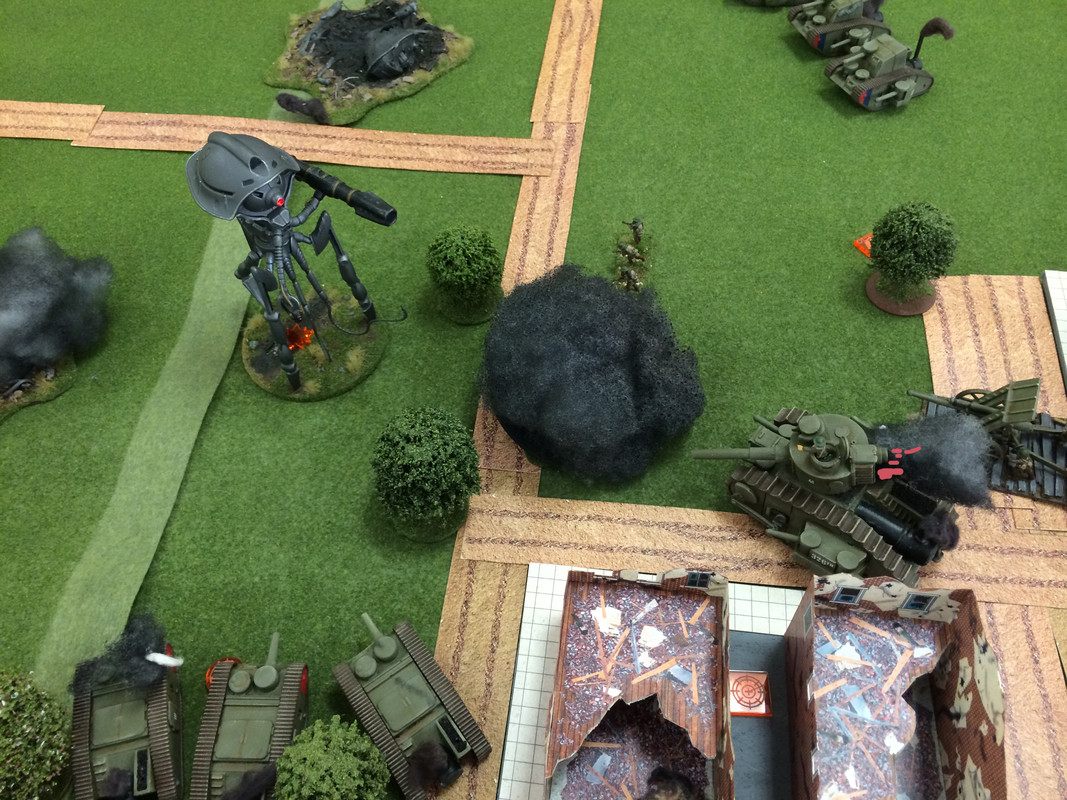
A heat ray also destroyed the second Mk II tank in the leftmost platoon, but the survivor held fast.
The Americans again won the initiative for Turn 4. More troops came out of hiding in the town, including several machine gun squads. The Martians were also now in range of the mortar squads hidden among the buildings. More fire flayed the Martians piling on armor hits and another tripod fell in ruin. That was four gone. Only one more to break the Martian force!

But the Martians were not through yet. Continuing to advance on the town, they wiped out an infantry platoon and finished off the tank platoon there. Black dust killed some of the Machine gunners.
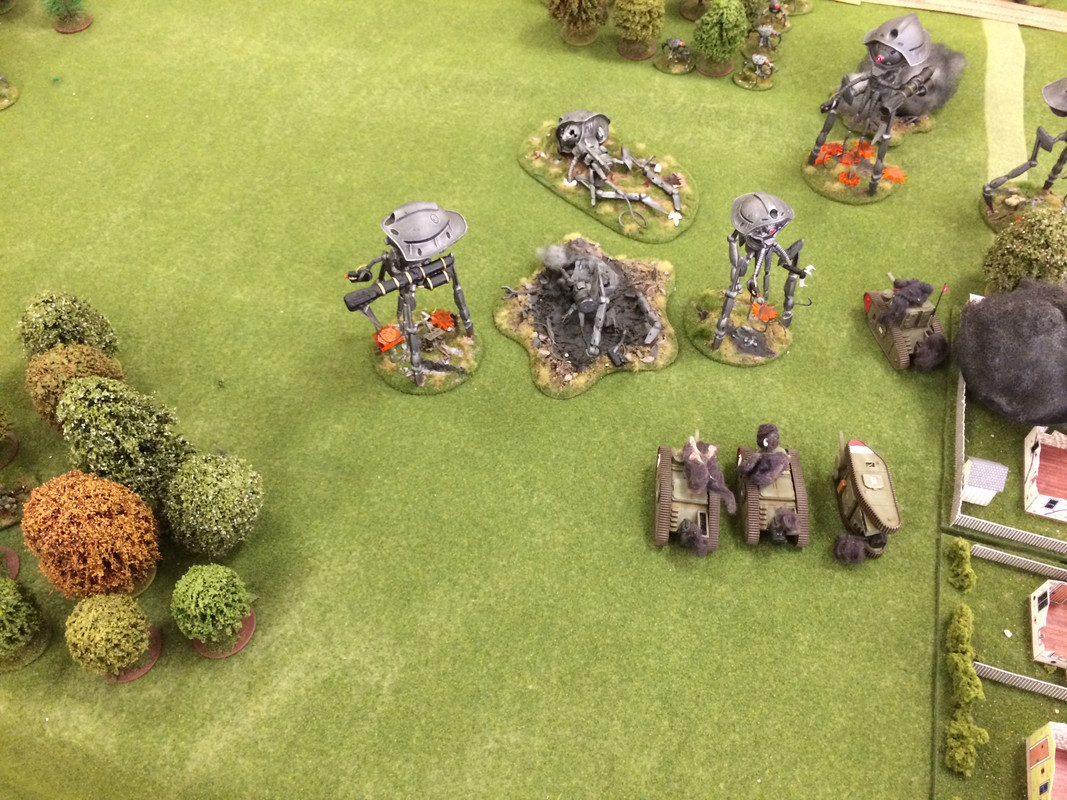
On the left, the drones advanced and destroyed the second infantry platoon in the woods.
And now the Martians won the initiative for Turn 5 and got a double move like the humans had earlier!
On the left the drones continued their remorseless advance, charging the field battery there and cutting down the hapless gunners in a close assault.
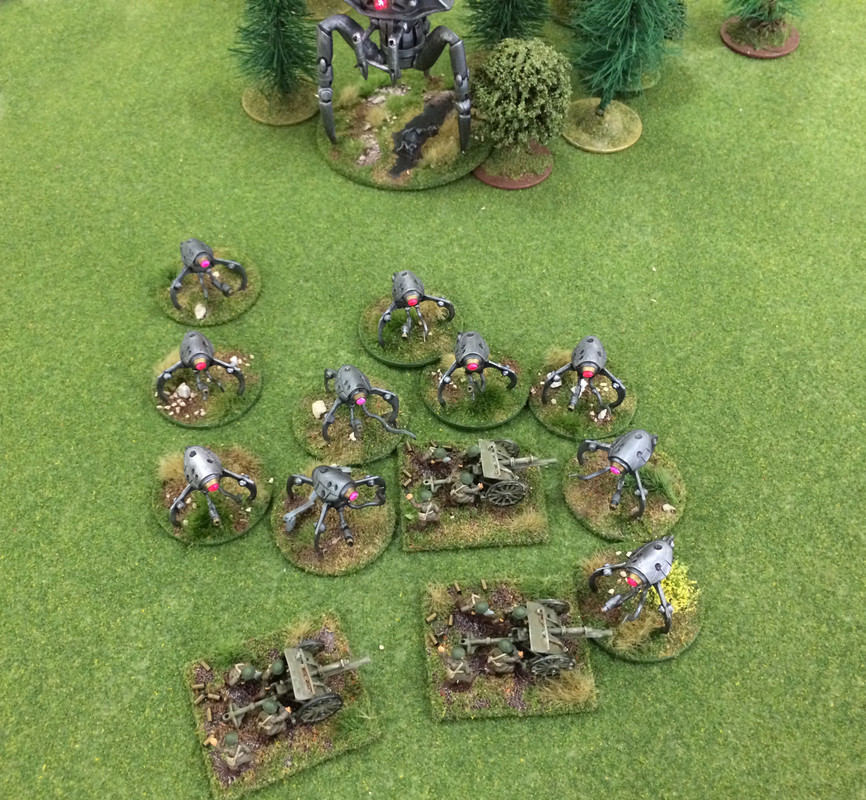
In the town, the two remaining assault tripods smothered the defenders with black dust, killing many of them.
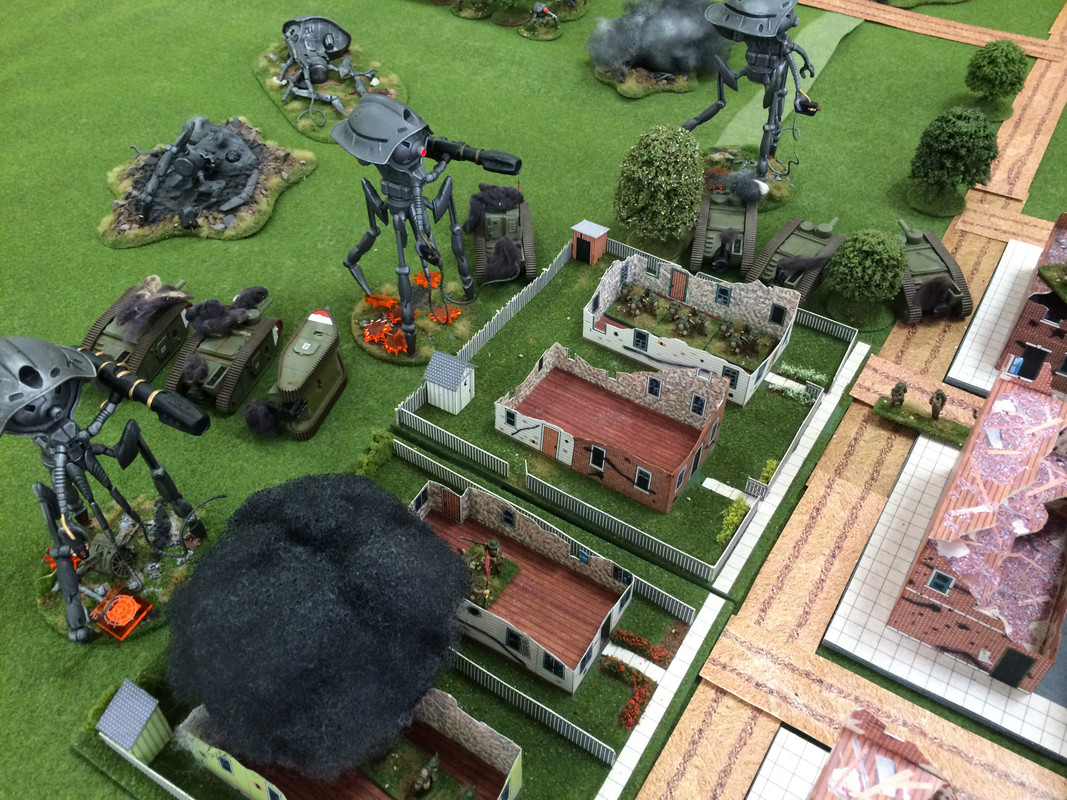
And using a double move, a scout tripod charged down the streets—stepping right over a mortar squad—and came in sight of the supply depot! It used its heat ray to destroy one of the heavy guns positioned there.
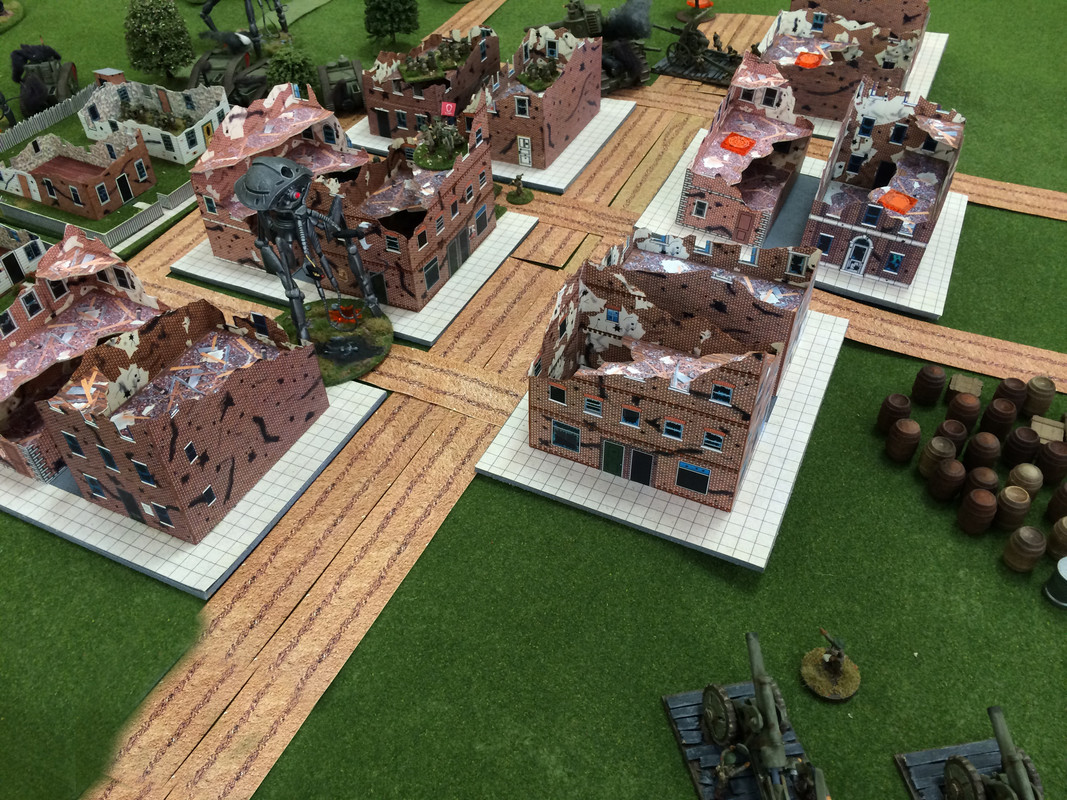
Things had taken a decidedly bad turn for the humans. The Martians were approaching the supply depot and the army was suddenly dangerously close to its own break point. But now it was their turn. The assault tripod in the streets was right next to where the battalion commander had made its headquarters. He sent out the order for everything to concentrate on it. Rallying an infantry platoon he led it in a desperate assault.

Already damaged, the tripod was pounded by tanks and flayed by machine guns. The bombs in the infantry squad peeled away the tripod’s armor. And then, then, the platoon’s stovepipe rocket launcher, the stovepipes which so far had done nothing whatsoever in the battle, scored a hit! The alien machine trembled, smoke poured out of a ragged hole in its head, and the machine crashed to the ground!

Despite the fact that the scout tripod was within striking distance of the supply depot, the Martian commander had had enough. The clan simply could not sustain these sort of losses. Even if the depot were destroyed, would any of the Martians be able to escape? No, it just was not worth it. It gave the order to retreat. The humans watch in relief as the invaders fled.
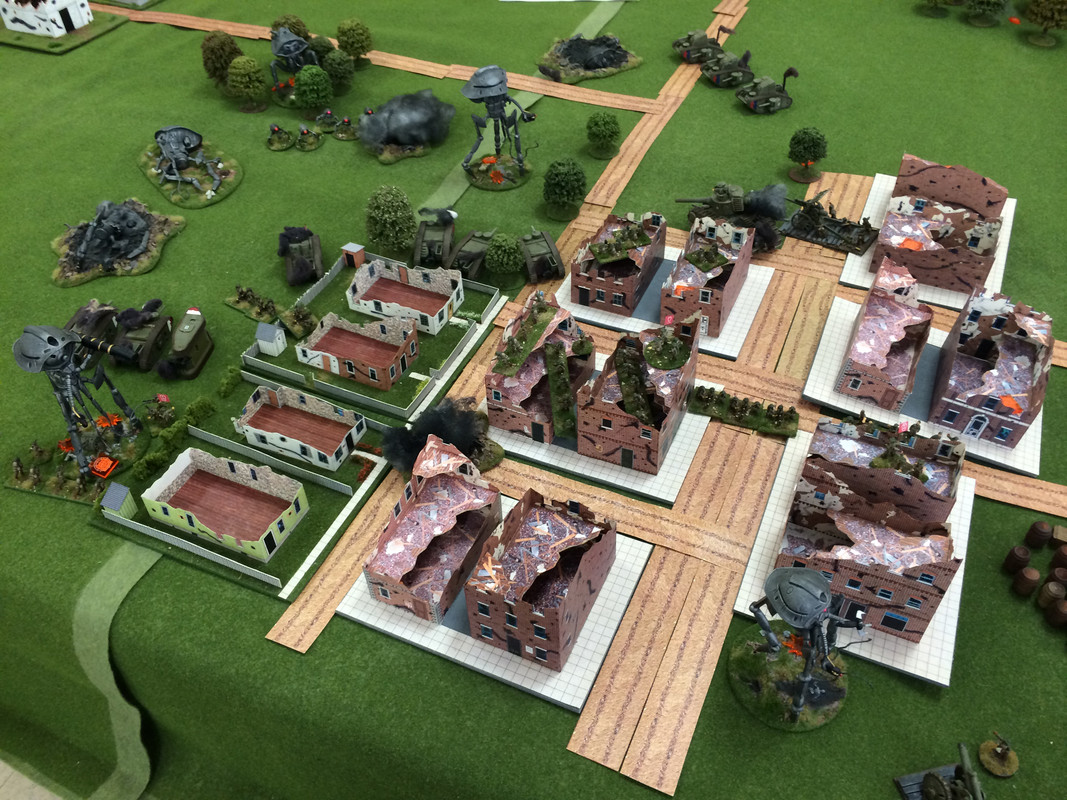
Well! This was a fun game. Initially it looked like it was going to be an easy human victory, But the Martians showed again how quickly the prey-creatures could die once they got into range. It had been a very near-run thing indeed.
The All Quiet game system is an excellent one. It runs quickly and simply but can be easily modified with things like aircraft, ships, and stovepipe rocket launchers without overly complicating the game. It is fun to play and the models really look great. Highly recommended.
*The story of the Battle of St. Louis can be found here: www.barnesandnoble.com/w/the-great-martian-war-scott-washburn/1125757616?ean=9781945430114&st=PLA&sid=BNB_New+Core+Shopping+Books&sourceId=PLAGoNA&dpid=tdtve346c&2sid=Google_c&gclid=EAIaIQobChMI66uDg6-73gIVyoCfCh1EBQxaEAYYASABEgIuhfD_BwE
Background
Following their devastating defeat at the Battle of St. Louis in June, the Martians of Clan Mavnaltak fell back toward their fortified holdfast near Kansas City.* General Leonard Wood, Chief of Staff of the US Army, dearly wanted to follow up on his victory and pursue the defeated enemy before they could recover. Unfortunately, by all indications Martian forces further south were preparing a major attack on the city of Memphis. The security of the Mississippi Defense Line was of primary importance and he did not have the reserve forces to mount a major drive toward Kansas City. However he did authorize General John Pershing, Commander of the 6th Army at St. Louis to mount whatever pursuit he felt could be safely undertaken with the forces at his disposal.
Pershing’s XV Corps, had been too badly battered in the defense of St. Louis to undertake such an operation, but the two other corps in 6th Army had not been engaged at all. Realizing that their sectors were in no immediate danger, Pershing created a new formation using units drawn from those corps, along with some support units from XV Corps. These units, supported by navy gunboats and monitors, moved cautiously westward, following the Missouri River during July.
Clan Mavnaltak was in a precarious position. They observed the prey-creature force approaching their holdfast with considerable alarm, but their losses at St. Louis had been so heavy they could not risk another major battle. In early August, their scouts noted that the prey-creatures had a substantial supply depot in the ruins of Jefferson City, along the Missouri River. It was decided that a fast strike against this depot might slow or even halt the enemy advance. A decoy force was sent to draw enemy forces away from the depot, while the raiding force moved into position.
American aircraft detected this force mere hours before it attacked. There was no time to send significant reinforcements to Jefferson City, but the defenders were on full alert when the Martian arrived, just before noon on August 6th.
The Battlefield
The land around Jefferson City is mostly flat with scattered patches of woods. The city and surrounding farms had been destroyed by the Martians when they swept through the area in 1910. There are substantial ruins where the city once stood. The Missouri river, flowing west to east was to the north of the city.

The Supply Depot

The Opposing Forces
The defense of the supply depot at Jefferson City had been assigned to the 1st battalion of the 109th Infantry Regiment. They were part of the 28th Division, the ‘Keystone Division’. Originally a Pennsylvania National Guard unit, the 28th had suffered heavy losses at the Battle of Santa Fe in 1910. While it had been rebuilt since then, the influx of new recruits had diluted the Pennsylvania flavor of the division, although they still proudly wore the red Keystone insignia on their uniforms. The battalion was structured along the lines of the newly adopted 1911 regulations, so it had three rifle companies, each of three rifle platoons and a machine gun platoon. The 4th company, the weapons company, had two machine gun platoons and two mortar platoons. All of the rifle platoons had one of new anti-tripod rocket launchers recently invented by Dr. Robert Goddard and called by the troops ‘stovepipes’.
The battalion was supported by two batteries of field artillery and an anti-tripod gun. By good fortune, a company of tanks, one of the massive Mk IV heavy tanks, and a battery of heavy artillery had been unloaded from barges just the day before and were available to join in the defense. A single flight of Burgess-Dunne D8 aircraft were observing the Martian approach and would be there for the coming battle. Finally, the Olmstead-class river gunboat, the USS Osceola, was on the river ready to lend its gunfire, if necessary.
The Martian attack force was a modest one consisting of five assault tripods, two mounting black dust projectors, three scout tripods, and two slaver tripods controlling twenty four drones.
Deployment
The Bulk of the human forces were deployed in and around the ruins of Jefferson City. B, C & D company held the town, long with the tanks. The heavy artillery battery was near the supply depot.

The two field batteries were deployed in open ground to the south of the city, supported by A Company of the 109th. The aircraft were circling in that same vicinity.

All of the infantry was deployed as hidden ‘blips’ and would only be revealed if they fired, or if a Martian unit came within 6” of them. A number of decoy blips were also deployed.
The Osceola was steaming near the supply depot.

The Martians arrived along the southwest table edge, the drones clustering close to the slavers, which controlled them.

Both sides were given ten command tokens. The Martians could use them to give a double move to a unit. The Humans could use them for double-moves, to rally routed units, and bring back destroyed units as reinforcements.
The victory conditions were simple: The Martians would win if they destroyed the supply depot. The Humans would win if they prevented this. Each army had a break point of 50%. Once half of their starting units were destroyed, they would be forced to retreat.
The Battle
The Martians were given the initiative and made the first move. One of the Martian subordinates advised a rapid move to the north, up to the river and then a sweep east to the supply depot. This would leave the prey-creature forces to the south of the town unengaged and perhaps avoid a costly fight through the streets of the ruined city. The force commander, Icwelaner, was very wary of the prey-creature warship on the river. Such things had proven extremely dangerous in the past. It overruled its subordinate and decided upon an advance due east. Once the enemy forces to the front had been destroyed, the attack force would turn north and attack the supply depot.
Turn 1 saw the Martians advance straight ahead, expended several command token to speed movement. The only thing within range of their weapons were a few blip tokens, which when fired upon proved to be decoys.

During their second move (All Quiet on the Martian Front uses a move-shoot-move turn system). A scout tripod on the extreme Martian right discovered a prey-creature infantry platoon in a patch of woods.

The human turn saw them moving their forces into positions where they could fire better. The tank platoons moved out of the streets and deployed in the open areas on the edge of town. The Mk IV tank used a command token to double move, but could not quite get a shot.

On the left, the discovered platoon charged boldly into contact with the scout tripod, hurling their explosive bombs and trying out their new-fangled stovepipe rocket launcher. The circling aircraft also headed for the scout, machine guns blazing. The assault was not terribly effective, the inexperienced rocket gunner sending his missile off into the trees. But an armor hit was scored and this was no little thing. An undamaged Martian machines was nearly invulnerable to small arms fire, but each armor hit left them more and more vulnerable. It would be easier to hit the scout the next time.

Over toward the town, the human defenders opened fire with everything that could be brought to bear. The heavy artillery battery dropped a barrage on the nearest slaver and although no damage was done on the tripod, two of the drones were blown to bits by the heavy shells. The tanks and field batteries, the anti-tripod gun and the 6” gun on the Osceola all blazed away and scored a number of armor hits on several of the tripods. No serious damage, but the Martian machines were becoming more vulnerable. On the humans’ second move, the infantry platoon on the left retreated back into the woods, and the aircraft turned away, not wanting to bring their fragile craft too close to the massed enemy tripods. In the town the Mk IV tank lurched into position where it could fire on the following turn.

On turn two each side rolled a die to win the initiative for the turn and the humans won! This feature of the game system will, from time to time allow one side to get a double move and that is what happened here. The humans moved second on Turn 1, and now first on Turn 2. They could pound the Martians again!
The humans repositioned a few of their tanks and the infantry squad on the far left again charged out of the woods against the scout tripod. The flight of aircraft regretted turning away from the enemy in the second move of the previous turn as they were now too far away to attack this turn.
Fire rained down on the enemy again. The heavy artillery battery blasted away at the slaver and it’s drones and this time scored a hit on the slaver, not only knocking off an armor point but also damaging it’s directional controls. When it tried to move again, it might move in some direction the Martians did not want. Two more of the drones were destroyed as well. Fire from the other field batteries and the Mk II tanks near the town piled on more armor hits and also damaged the weapons control system of one of the assault tripods.

Then the three Mk III steam tanks on the far right trained their nine 4” guns on the nearest tripod and scored seven hits. That tripod had already suffered several armor hits so when the rolls were made to penetrate the armor five made it through! This meant a roll on the damage table with a +4 to the roll. Not surprisingly, the tripod exploded. Not only was it destroyed, but another nearby tripod suffered an armor hit. A cheer went up from the human lines.

Over on the far left, the plucky infantry platoon again assaulted the scout tripod, but scored no hits this time.
Finally, it was the Martian turn. The long-legged tripods continued their advance—except for the damaged slaver who went the wrong way. One of the scouts got close enough to reveal another platoon of A Company on the left. They also got close enough to sweep a heat ray across the circling aircraft. Two of the planes burst into flames and fell from the sky, the third fled and did not return.

Another sweeping heat ray wiped out the newly revealed prey-creature platoon before it could fire a shot. Several longer range shots destroyed a steam tank and the tank platoon command tank. On the left, the lone scout finally managed to fire at the pesky infantry platoon in the woods—and missed!
With their second move the Martians continued to advance. Another infantry platoon was revealed in front of the field battery, and a machine gun squad in the woods. The scout on the far left decided it would leave the prey-creatures in the woods to the approaching slaver and drones and moved a double move toward the center.

The Humans won the initiative roll for turn 3 and moved first. They brought several platoons out of hiding in the town and moved them into position to fire. Cutting loose with everything they had, they pounded the approaching Martians.

Hit after hit was scored and then in quick succession a scout tripod exploded, and another assault tripod crashed to the ground, completely wrecked.

On the left the lone American platoon fired at the drones with no effect, but was heartened that another hidden platoon was moving up in support.

Well, things were looking very hopeful for the Americans. They had hurt the enemy badly. The Martian commander was starting to think that this operation had not been a good idea.
But it would obey its orders and continue the assault. On the left, the drones surged out of the ruined farm and quickly cut down every one of the irksome platoon in the woods. Of course this also revealed the second platoon ready to take its place.

Closer to the town, things also turned for the better. The black dust projector on one of the assault tripods destroyed two of the machine guns in the woods, and a sweeping heat ray annihilated the field battery with one shot.

On the edge of town, more black dust killed or routed another platoon and a focused heat ray blew through the heavy armor of the Mk IV tank like it was butter and the huge vehicle exploded in a ball of flame and steam.

A heat ray also destroyed the second Mk II tank in the leftmost platoon, but the survivor held fast.
The Americans again won the initiative for Turn 4. More troops came out of hiding in the town, including several machine gun squads. The Martians were also now in range of the mortar squads hidden among the buildings. More fire flayed the Martians piling on armor hits and another tripod fell in ruin. That was four gone. Only one more to break the Martian force!

But the Martians were not through yet. Continuing to advance on the town, they wiped out an infantry platoon and finished off the tank platoon there. Black dust killed some of the Machine gunners.

On the left, the drones advanced and destroyed the second infantry platoon in the woods.
And now the Martians won the initiative for Turn 5 and got a double move like the humans had earlier!
On the left the drones continued their remorseless advance, charging the field battery there and cutting down the hapless gunners in a close assault.

In the town, the two remaining assault tripods smothered the defenders with black dust, killing many of them.

And using a double move, a scout tripod charged down the streets—stepping right over a mortar squad—and came in sight of the supply depot! It used its heat ray to destroy one of the heavy guns positioned there.

Things had taken a decidedly bad turn for the humans. The Martians were approaching the supply depot and the army was suddenly dangerously close to its own break point. But now it was their turn. The assault tripod in the streets was right next to where the battalion commander had made its headquarters. He sent out the order for everything to concentrate on it. Rallying an infantry platoon he led it in a desperate assault.

Already damaged, the tripod was pounded by tanks and flayed by machine guns. The bombs in the infantry squad peeled away the tripod’s armor. And then, then, the platoon’s stovepipe rocket launcher, the stovepipes which so far had done nothing whatsoever in the battle, scored a hit! The alien machine trembled, smoke poured out of a ragged hole in its head, and the machine crashed to the ground!

Despite the fact that the scout tripod was within striking distance of the supply depot, the Martian commander had had enough. The clan simply could not sustain these sort of losses. Even if the depot were destroyed, would any of the Martians be able to escape? No, it just was not worth it. It gave the order to retreat. The humans watch in relief as the invaders fled.

Well! This was a fun game. Initially it looked like it was going to be an easy human victory, But the Martians showed again how quickly the prey-creatures could die once they got into range. It had been a very near-run thing indeed.
The All Quiet game system is an excellent one. It runs quickly and simply but can be easily modified with things like aircraft, ships, and stovepipe rocket launchers without overly complicating the game. It is fun to play and the models really look great. Highly recommended.
*The story of the Battle of St. Louis can be found here: www.barnesandnoble.com/w/the-great-martian-war-scott-washburn/1125757616?ean=9781945430114&st=PLA&sid=BNB_New+Core+Shopping+Books&sourceId=PLAGoNA&dpid=tdtve346c&2sid=Google_c&gclid=EAIaIQobChMI66uDg6-73gIVyoCfCh1EBQxaEAYYASABEgIuhfD_BwE




